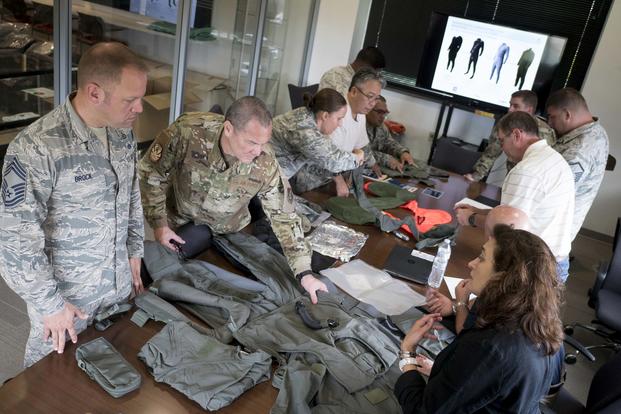U.S. Air Force F-22 Raptor pilots in Hawaii are some of the first to try out the service's new integrated aircrew ensemble (IAE) flight suit and gear.
Active-duty and Air National Guard pilots from the 199th and 19th Fighter Squadrons at Joint Base Pearl Harbor-Hickam will sport brand-new, custom-fit gear on stealth fighter missions next year, according to a recent Air Force news release.
Representatives from the Human Systems Program Office at Wright-Patterson Air Force Base, Ohio -- home to Air Force Material Command -- gave pilots the rundown on how to make the most of the upgraded and consolidated flight suits.
"It's all strategically placed so items are not on top of each other, [and] it minimizes the occurrence of friction, hot spots or wear-down on the system," Carl Medeiros, IAE program manager, said in the release.
Related content:
- The Air Force Is on a Mission to Fix its Uniforms
- Air Force Authorizes Two-Piece Flight Suits on Duty
- Why More Pilots Are Skipping the Flight Suit
- Air Force Collecting Feedback to Design Better-Fitting Flight Suits
"The material is also moisture-wicking, so it pulls moisture away from the body, removing and reducing thermal burden, while increasing mobility and comfort levels," he added. "When it all comes together, there's a direct correlation and improvement to the physiological effects on the pilot."
Typically, aircrew in bombers or fighters -- or anything with an ejection seat -- have layers of add-ons to their flight suits for a variety of contingencies. The Air Force is still offering options, but with a more streamlined and less bulky approach.
Depending on the mission, pilots can choose a combination of seven configuration items including a coverall, which provides heat and flame protection; survival vest; pressure vest; life preserver unit; a chemical, biological and radiological layer; thermal undergarment; and environmental protection layer, the Human Systems Program Office told Military.com.
IAE was tested and approved for all ejection seat aircraft, and the program is "currently in the production phase with the first scheduled roll-out to the F-22 fleet," the office said in an email.
"Unlike the currently used legacy equipment, which had been piecemealed with additional support items over several decades, each component of the IAE has been designed to complement all other items," according to the release. "Its material has been influenced by recent advancements in sports technology to aid aviators who endure harsh flight conditions."
The upgrades have been long in the making. According to an earlier Air Force news release, B-52 Stratofortress bomber crews began experimenting with a version of IAE in 2013. In 2016, the Defense Department awarded TIAX LLC of Lexington, Massachusetts, a $17.7 million contract delivery order on a previously awarded contract for initial operational test and evaluation (IOT&E) for IAE. The Pentagon at the time said that $9.6 million from fiscal 2015 research, development, test and evaluation (RDT&E) funds had also been allocated toward the effort.
In recent years, flight suits and better-fitting uniforms have become a priority for the service.
Air Force Chief of Staff Gen. David Goldfein has called for improved uniforms -- not only for comfort, but also for safety. Teams of airmen began reviewing not only flight suits, but all the gear needed to fly for hours on end.
Maj. Saily Rodriguez, the female fitment program manager for the Human Systems Program Office, recently told Military.com that she and her team had been working a number of initiatives -- some tailored toward men, others to women -- to get aviators better equipped before takeoff.
"Everything that touches an aircrew member's body, we manage in the program office," she said during an interview in April. That includes flight vests; G-suits, which prevent the loss of consciousness during high levels of acceleration or gravity pressure; helmets; boots; and other gear, such as a bladder relief apparatus.
The service in April approved the use of two-piece flight suits while on duty as an option to the one-piece flight duty uniform.
Raptor pilots are scheduled to receive the IAE uniform during the first half of 2020, the release states.
The Human Systems Program Office team has also visited Joint Base Langley-Eustis, Virginia, and the team is scheduled to visit Joint Base Elmendorf-Richardson, Alaska, next month, officials said.
-- Oriana Pawlyk can be reached at oriana.pawlyk@military.com. Follow her on Twitter at @Oriana0214.













